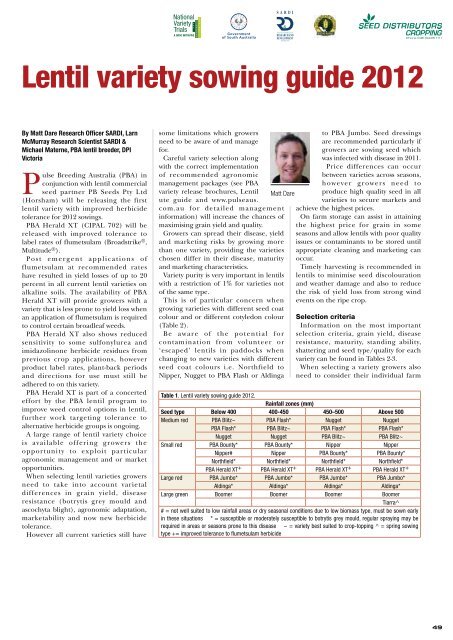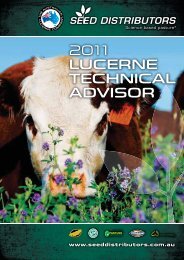Lentil variety sowing guide 2012 - Seed Distributors
Lentil variety sowing guide 2012 - Seed Distributors
Lentil variety sowing guide 2012 - Seed Distributors
Create successful ePaper yourself
Turn your PDF publications into a flip-book with our unique Google optimized e-Paper software.
<strong>Lentil</strong> <strong>variety</strong> <strong>sowing</strong> <strong>guide</strong> <strong>2012</strong><br />
By Matt Dare Research Officer SARDI, Larn<br />
McMurray Research Scientist SARDI &<br />
Michael Materne, PBA lentil breeder, DPI<br />
Victoria<br />
Pulse Breeding Australia (PBA) in<br />
conjunction with lentil commercial<br />
seed partner PB <strong>Seed</strong>s Pty Ltd<br />
(Horsham) will be releasing the first<br />
lentil <strong>variety</strong> with improved herbicide<br />
tolerance for <strong>2012</strong> <strong>sowing</strong>s.<br />
PBA Herald XT (CIPAL 702) will be<br />
released with improved tolerance to<br />
label rates of flumetsulam (Broadstrike ® ,<br />
Multitude ® ).<br />
Post emergent applications of<br />
flumetsulam at recommended rates<br />
have resulted in yield losses of up to 20<br />
percent in all current lentil varieties on<br />
alkaline soils. The availability of PBA<br />
Herald XT will provide growers with a<br />
<strong>variety</strong> that is less prone to yield loss when<br />
an application of flumetsulam is required<br />
to control certain broadleaf weeds.<br />
PBA Herald XT also shows reduced<br />
sensitivity to some sulfonylurea and<br />
imidazolinone herbicide residues from<br />
previous crop applications, however<br />
product label rates, plant-back periods<br />
and directions for use must still be<br />
adhered to on this <strong>variety</strong>.<br />
PBA Herald XT is part of a concerted<br />
effort by the PBA lentil program to<br />
improve weed control options in lentil,<br />
further work targeting tolerance to<br />
alternative herbicide groups is ongoing.<br />
A large range of lentil <strong>variety</strong> choice<br />
is available offering growers the<br />
opportunity to exploit particular<br />
agronomic management and or market<br />
opportunities.<br />
When selecting lentil varieties growers<br />
need to take into account varietal<br />
differences in grain yield, disease<br />
resistance (botrytis grey mould and<br />
ascochyta blight), agronomic adaptation,<br />
marketability and now new herbicide<br />
tolerance.<br />
However all current varieties still have<br />
some limitations which growers<br />
need to be aware of and manage<br />
for.<br />
Careful <strong>variety</strong> selection along<br />
with the correct implementation<br />
of recommended agronomic<br />
management packages (see PBA<br />
<strong>variety</strong> release brochures, <strong>Lentil</strong><br />
ute <strong>guide</strong> and www.pulseaus.<br />
com.au for detailed management<br />
information) will increase the chances of<br />
maximising grain yield and quality.<br />
Growers can spread their disease, yield<br />
and marketing risks by growing more<br />
than one <strong>variety</strong>, providing the varieties<br />
chosen differ in their disease, maturity<br />
and marketing characteristics.<br />
Variety purity is very important in lentils<br />
with a restriction of 1% for varieties not<br />
of the same type.<br />
This is of particular concern when<br />
growing varieties with different seed coat<br />
colour and or different cotyledon colour<br />
(Table 2).<br />
Be aware of the potential for<br />
contamination from volunteer or<br />
‘escaped’ lentils in paddocks when<br />
changing to new varieties with different<br />
seed coat colours i.e. Northfield to<br />
Nipper, Nugget to PBA Flash or Aldinga<br />
Matt Dare<br />
to PBA Jumbo. <strong>Seed</strong> dressings<br />
are recommended particularly if<br />
growers are <strong>sowing</strong> seed which<br />
was infected with disease in 2011.<br />
Price differences can occur<br />
between varieties across seasons,<br />
however growers need to<br />
produce high quality seed in all<br />
varieties to secure markets and<br />
achieve the highest prices.<br />
On farm storage can assist in attaining<br />
the highest price for grain in some<br />
seasons and allow lentils with poor quality<br />
issues or contaminants to be stored until<br />
appropriate cleaning and marketing can<br />
occur.<br />
Timely harvesting is recommended in<br />
lentils to minimise seed discolouration<br />
and weather damage and also to reduce<br />
the risk of yield loss from strong wind<br />
events on the ripe crop.<br />
Selection criteria<br />
Information on the most important<br />
selection criteria, grain yield, disease<br />
resistance, maturity, standing ability,<br />
shattering and seed type/quality for each<br />
<strong>variety</strong> can be found in Tables 2-3.<br />
When selecting a <strong>variety</strong> growers also<br />
need to consider their individual farm<br />
Table 1. <strong>Lentil</strong> <strong>variety</strong> <strong>sowing</strong> <strong>guide</strong> <strong>2012</strong>.<br />
<strong>Seed</strong> type Below 400<br />
Rainfall zones (mm)<br />
400-450 450–500 Above 500<br />
Medium red PBA Blitz~ PBA Flash* Nugget Nugget<br />
PBA Flash* PBA Blitz~ PBA Flash* PBA Flash*<br />
Nugget Nugget PBA Blitz~ PBA Blitz~<br />
Small red PBA Bounty* PBA Bounty* Nipper Nipper<br />
Nipper# Nipper PBA Bounty* PBA Bounty*<br />
Northfield* Northfield* Northfield* Northfield*<br />
PBA Herald XT + PBA Herald XT + PBA Herald XT + PBA Herald XT +<br />
Large red PBA Jumbo* PBA Jumbo* PBA Jumbo* PBA Jumbo*<br />
Aldinga* Aldinga* Aldinga* Aldinga*<br />
Large green Boomer Boomer Boomer Boomer<br />
Tiarra^<br />
# = not well suited to low rainfall areas or dry seasonal conditions due to low biomass type, must be sown early<br />
in these situations * = susceptible or moderately susceptible to botrytis grey mould, regular spraying may be<br />
required in areas or seasons prone to this disease ~ = <strong>variety</strong> best suited to crop-topping ^ = spring <strong>sowing</strong><br />
type += improved tolerance to flumetsulam herbicide<br />
49




